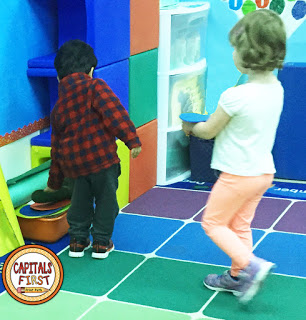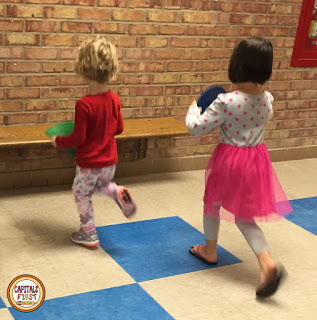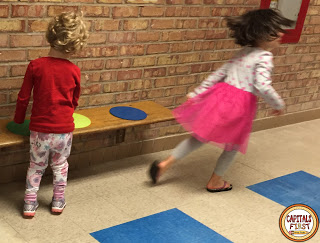BEST PRACTICES
Preschool teachers and classrooms that teach social, emotional, and self-regulation skills are ones that best prepare children for academic and social success in kindergarten (Nix, Bierman, Domitrovich, & Gill: 2013). Yet children from underserved populations, who most need the highest quality preschool experiences, are frequently in chaotic rooms ( LoCasale-Crouch, Jennifer, et al.: 2007).
Transitioning from one activity to the next is a time when children are most likely to demonstrate challenging behaviors (Hemmeter, Ostrosky, Artman, and Kinder: 2008). Any of us who have worked with preschool age children in a classroom know that it can be difficult to keep order when transitioning a group from one activity to another. This is particularly true when your class needs to leave your classroom!
BEST PRACTICES IN ACTION

 Many preschool teachers use dots or some sort of place marker to indicate where children should sit or stand. As a school-based occupational therapist, I have witnessed this practice countless times and know that it is hugely beneficial in helping children understand where they should be and what they should do.
Many preschool teachers use dots or some sort of place marker to indicate where children should sit or stand. As a school-based occupational therapist, I have witnessed this practice countless times and know that it is hugely beneficial in helping children understand where they should be and what they should do. This year I have the pleasure to work with a brilliant teacher Stephany, who orchestrates multiple flawless transitions for her classroom.
This year I have the pleasure to work with a brilliant teacher Stephany, who orchestrates multiple flawless transitions for her classroom.
She brings a new twist to the use of poly-dots. As she calls children’s names to go to stand in line when going to the bathroom, the kids pick up and carry the dot that they have been sitting on.
 When they are done in the bathroom, her students know exactly where to sit and wait while the teacher is inside the bathroom assisting other students.
When they are done in the bathroom, her students know exactly where to sit and wait while the teacher is inside the bathroom assisting other students.As an occupational therapist, I love the extra potential learning opportunities that arise when the kids have a dot in their hands.

As they walk down the hall, students practice directionality and body awareness. Sometimes they walk with the dots in front of them, sometimes on their head, and to the left we see them walking with the dots held in their left hands.

When returning from the bathroom, children will go to sit at their table spots. They don’t need the dots anymore, so they put the dots in a tub where they are within easy reach of the teacher.
What are your favorite preschool transition tricks?
[inlinkz_linkup id=670897 mode=1]
[inlinkz_linkup id=678932 mode=1]





I love your ideas for transitions, which are so hard for so many of our kids. I'm going to share these ideas with the teachers with whom I work. Thanks.
These dots look great. We have used carpet squares in the past but they are more cumbersome for the students to handle. I like the ideas on how to use them.
This is a wonderful idea, Thia! Thank you for sharing!